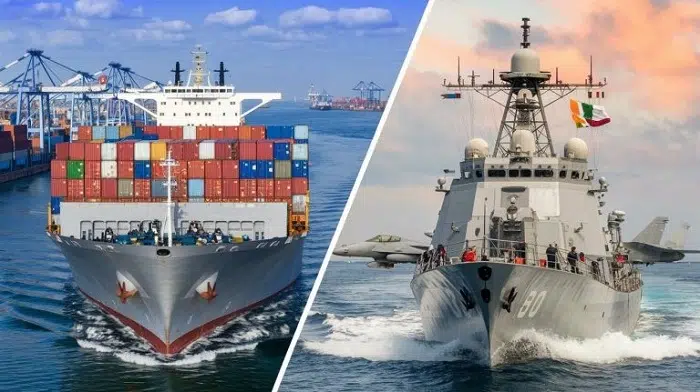Ever seen a flag with an anchor? Or a ship wheel with wings? That’s the Merchant Navy symbol! You’ll spot it on ships. On uniforms. On medals. Even on old war posters.
It’s not just a badge, you know? It stands for brave people. For trade. For folks who keep the world moving by sea. The Merchant Navy? They don’t fight wars. They work hard. They serve. They keep things going when times get tough.
Let’s jump in! We’ll check out where this symbol came from. What it means. And why it still matters today.
What Is the Merchant Navy Symbol
The Merchant Navy symbol is a mark of honor. Simple as that. It shows an anchor in the middle. There’s usually a rope circle around it. Or maybe some leaves. Sometimes you’ll see a crown on top. Or a flag behind it.
Each country has its own style. But the idea? Same thing. The anchor means steady seas. The crown or flag? That’s the nation it serves. The rope means we’re all in this together.
When you see that symbol, you know what’s up. It’s a sailor who trades, not fights. Someone who keeps our world connected.
What the Merchant Navy Is
Wait, what’s the Merchant Navy anyway? Good question!
It’s the ships that carry stuff. Goods. Fuel. Food. People too. They cross oceans every day. They’re not war ships. They’re trade ships. But when war comes? They help out big time.
In peace, they run world trade. In war, they risk their lives. They keep supplies moving. That’s why their symbol is so proud. It shows duty. And brave hearts.
The Anchor: Heart of the Symbol
Every badge has one key part. The anchor.
The anchor? It’s old. Really old. It means hope. It means staying put. For sailors, it’s life itself. Drop the anchor? You stop drifting. You can rest.
Way back, the anchor was even a secret sign. It meant faith. Safety. So when the Merchant Navy picked it? It made perfect sense. It speaks to all sailors everywhere.
How the Symbol Started
The idea came long ago. Ships carried goods between countries. People saw that ships needed pride. And protection too.
Back in the 1600s and 1700s? Trade ships were huge deals. Britain, Spain, the Netherlands, they all built big fleets. They made flags for their traders. So everyone knew who was who.
The symbol we know today? It grew from those old ones. Take Britain’s Merchant Navy. They got official in 1835. Their symbol mixed the anchor, crown, and flag, the Red Ensign.
Other countries made their own designs. But the meaning? Same thing. Peace-loving sailors serving through trade.
The Merchant Navy Flag
Most ships fly a special flag. In many places, it’s red. Has a small country flag in the corner. For the UK? They call it the Red Ensign. Or the “Red Duster.”
Other nations have their own:
• India uses three colors. Plus a navy blue wheel and anchor.
• Australia and New Zealand? They use Red Ensigns too.
• Canada used it once. Then they got their maple leaf.
That flag tells everyone at sea something. This is a trade ship. Not a war ship. It means trade. And freedom.
The Crown and Rope
See that crown on top? That’s service to the nation. In the UK and places like it? It means being loyal to the king or queen.
The rope circle? Or those leaves? That’s teamwork. Every sailor needs the next one. On ships, teamwork isn’t a choice. It’s how you survive. The circle shape? No one’s above or below. We’re all linked up.
Merchant Navy During War
The Merchant Navy became legends in the world wars. These sailors didn’t use guns. They used guts.
During both big wars? They carried fuel. Food. Weapons too. Across dangerous seas. Enemy subs hunted them. Many ships never came back. But they kept going.
The anchor symbol got new meaning then. It meant brave hearts. Giving up everything. Duty without glory. These weren’t soldiers. But they served like heroes.
After the wars? The flag and badge became respect symbols. Memorials around the world honor these sailors. With anchors. With rope designs.
The Merchant Navy Badge and Uniform
Every sailor wears a badge. Or a patch. Shows the anchor. It’s part of what they wear.
Officers get special ones. Gold or silver anchors. With crowns and stars. Junior sailors? Simpler designs.
But the anchor? It ties them all together. Reminds them they share the same job. Keep the ships moving. No matter what.
Merchant Navy Medals and Honors
After the wars, governments made medals. For Merchant Navy service. The British medal? Shows the anchor and crown. Waves underneath.
These medals honor brave sailors. Some didn’t fight with weapons. But they kept supplies flowing. Without them? Countries would have fallen.
The medal says thank you. Not just for trade. For guts. For faith in hard times.
Merchant Navy Symbols in Different Countries
Every country adds its own twist.
- United Kingdom: Anchor, crown, Red Ensign flag.
• India: Blue anchor. Three colors. Ashoka Chakra (that’s a wheel).
• Australia: White anchor. Navy blue. Stars.
• Canada: Maple leaf meets anchor.
• Japan: Anchor with rope. Rising sun symbol.
Each shows trade. Pride. Love of country. But they all have the same heart. The anchor.
The Symbol in Training and Education
Navy schools use the symbol too. On gates. Badges. Papers you get when you finish.
It tells new sailors something. You’re joining something old. Noble. Proud.
Students learn to sail. And to serve. The symbol reminds them, work together. Trust each other. At sea, ranks don’t matter much. Unity does. That’s the rope circle.
Also Read: Rare Rabbit Symbol Explained: Meaning, Story, and Why It Still Fascinates People
The Symbol in Modern Times
Today? World trade runs on ships. Containers. Oil. Food. Cars. All by sea. Every ship carries the Merchant Navy spirit.
The anchor still shows up. On ship papers. Company logos. Training papers. It’s respect for sailors who connect the world.
Even with planes and satellites? Sea trade still rules. The symbol reminds us. Oceans keep our world alive.
Merchant Navy in Peace and Progress
The Merchant Navy? Not just about old times. It’s about peace. About connecting people.
Ships with this flag bring nations closer. They carry goods. Ideas. People. Keep money flowing. The anchor fits perfectly, steady. Strong. You can count on it.
See that symbol on a ship? On a sailor’s chest? Not just a logo. It’s a promise. To serve the world. Work hard. Be honest.
Merchant Navy in Art and Culture
You’ll see the symbol in paintings. Old posters. Stone monuments. Often with ocean waves. Seagulls. Compasses.
In the 1940s? Posters with the Red Ensign and anchor got people excited. Join up! Support the Navy! They called it “the lifeline of the nation.”
Even now, artists use it. Shows courage. Calm. Strength. Sailors still get anchor tattoos. Means faith. Coming home. Same feelings the symbol gives.
What the Merchant Navy Symbol Teaches Us
The symbol teaches simple stuff. But powerful:
• Be steady. Like an anchor.
• Stay connected. Like rope.
• Serve with pride. Like a crown.
• Keep moving. Like a ship at sea.
It reminds us of something. Not all heroes wear uniforms. Or carry weapons. Some just sail. Day and night. Through storms. Through danger. To keep the world running.
The Merchant Navy symbol looks simple. An anchor. A rope. Maybe a crown. But it means so much.
It stands for guts. Service. The endless link between nations.
It honors quiet sailors. Who gave their lives. Reminds us the sea connects us all.
Next time you see that anchor? On a flag? A uniform? Stop for a second. Think about thousands of people. Men and women. Who carried food. Medicine. Hope. Across rough waters.
That’s what it really means. Strength. Faith. The spirit of the sea.



